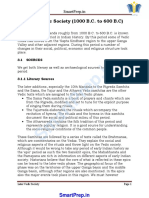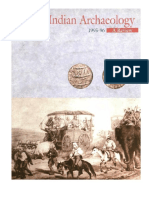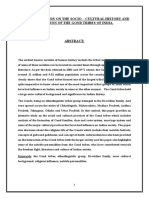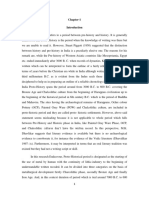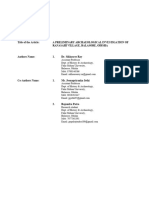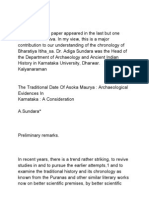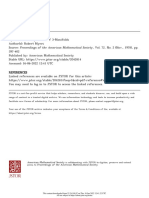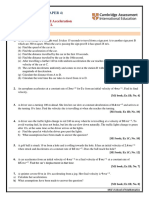0 ratings0% found this document useful (0 votes)
314 viewsClarke D Archaeology The Loss of Innocence PDF
Clarke D Archaeology The Loss of Innocence PDF
Uploaded by
Chico PuglieseArchaeology has lost its innocence as the field has become more sophisticated and self-conscious over time. This transition involved three phases - from naive innocence to technical self-consciousness to a more philosophical critical self-consciousness. Recent decades have seen especially rapid changes to the disciplinary environment and content, compressing this transition into one lifetime. The new environment is marked by greater debate, uncertainty, and a need to critically examine assumptions in light of limitations of evidence and theory.
Copyright:
© All Rights Reserved
Available Formats
Download as PDF, TXT or read online from Scribd
Clarke D Archaeology The Loss of Innocence PDF
Clarke D Archaeology The Loss of Innocence PDF
Uploaded by
Chico Pugliese0 ratings0% found this document useful (0 votes)
314 views13 pagesArchaeology has lost its innocence as the field has become more sophisticated and self-conscious over time. This transition involved three phases - from naive innocence to technical self-consciousness to a more philosophical critical self-consciousness. Recent decades have seen especially rapid changes to the disciplinary environment and content, compressing this transition into one lifetime. The new environment is marked by greater debate, uncertainty, and a need to critically examine assumptions in light of limitations of evidence and theory.
Original Title
clarke-d-archaeology-the-loss-of-innocence.pdf
Copyright
© © All Rights Reserved
Available Formats
PDF, TXT or read online from Scribd
Share this document
Did you find this document useful?
Is this content inappropriate?
Archaeology has lost its innocence as the field has become more sophisticated and self-conscious over time. This transition involved three phases - from naive innocence to technical self-consciousness to a more philosophical critical self-consciousness. Recent decades have seen especially rapid changes to the disciplinary environment and content, compressing this transition into one lifetime. The new environment is marked by greater debate, uncertainty, and a need to critically examine assumptions in light of limitations of evidence and theory.
Copyright:
© All Rights Reserved
Available Formats
Download as PDF, TXT or read online from Scribd
Download as pdf or txt
0 ratings0% found this document useful (0 votes)
314 views13 pagesClarke D Archaeology The Loss of Innocence PDF
Clarke D Archaeology The Loss of Innocence PDF
Uploaded by
Chico PuglieseArchaeology has lost its innocence as the field has become more sophisticated and self-conscious over time. This transition involved three phases - from naive innocence to technical self-consciousness to a more philosophical critical self-consciousness. Recent decades have seen especially rapid changes to the disciplinary environment and content, compressing this transition into one lifetime. The new environment is marked by greater debate, uncertainty, and a need to critically examine assumptions in light of limitations of evidence and theory.
Copyright:
© All Rights Reserved
Available Formats
Download as PDF, TXT or read online from Scribd
Download as pdf or txt
You are on page 1of 13
.
~Archaeology : the loss of innocence
DAVID CLARKE
We p.S#&$ IQst year two mticles dealing with the a i m and relevante of the so-called 'nem
first was by Professor Ri chrd Watson (1972, 210-15) and the second by
,301-4). We also pubhhed a r h by David Chke of 'Explanation
tson, S. A. LeBlanc and C. L. Redman (1972, 237-9). Here,
nd Tutor of Peterhouse, Cambridge, sets out his com'dered views
archaeology, some of which he has already dkeussed in h& book
'Analytical mchaeologyY.
linary innocence is the price by a network of changing methodology and
ef e%pali~:&~usness; certainly the price implicit theo ry. Teaching, now formalized in
b high bdd&e 105s is irreversible and the prize academies and universities, attempts to con-
dense experiente within general principles and
ence is explicit rules; it is no longer possible either to
rtheless teach or to learn the vast body of data and
cant thresholds in the transi- complex procedures by rote. Instead, classes of
ess through self-coonsciou data and approaches are treated in terms of
and beyond. alternative models and rival paradigms; in-
d when the evitably, the comparison of classes introduces
defined by counting and measuring which in turn entails a
raw material and by pragmatic modest amount of mathematical and statistical
aeology is what archaeologists do. methods and concepts.
linked This process is also marked by the emergence
partition of of competitive individualism and authority,
es and tacit since the individual's living depends on the
ation and reputation he achieves as a focus in the media or
correction in the craft style (Alexander, 1964, by innovation and intensive work in a specialist
a -
1-60). field. The politics and sociology of the disci-
Gradually consciousness develops into self- pl i nar~ environment increasingly develop this
cons&ss and sophistication erodes the 'authoritarian' state in which each expert has a
paradigms of innocence. Self-consciousness specialist territory such that criticisms of
dawns with explicit attempts at self-knowledge territorial observations are treated as attacks
-the contentious efforts to cope with the upon personalities. This gradually becomes a
growing quantity of archaeological observations seriously counterproductive vestige of a for-
by explicit but debated procedures and the merly valuable disciplinary adaptation by
querulous definition of concepts and classifica- means of which authorities mutually repelled
tions. The discipline emerges as a restless body one another into dispersed territories, thus
of observations upon particular classes of data, effectively deploying the few specialists over the
between a certain range of scales, held together growing body of data.
- - -
\
ARCHAEOLOGY: THE LOSS OF INNOCENCE
the new sophisticates indut$riously sub- upon us by the consequences of the
their discipline; each group deepens (Clarke 1970, 27; 197zb, 7-10).
ecialist cells by wncentrated research, In the new era of critical self-wnsciousnesb
the discipline rewgnizes that its domain is as
A
much defined by the characteristic fonns of its
reasoning, the intrinsic nature of its knowledge
I
I
and information, and its competing theories of
concepts and their relationships-as by the
elementary specification of raw material, scale
of study, and methodology. Explanation,
interpretation, wncepts and theory become
wmmon central topics of debate and develop the
esential significance of archaeological logic,
epistemology and metaphysics. It is apparent
the that archaeologists need to know about knowing
and the limits of what they can and cannot
form or national wntext. Self- know from the data and to know this by critical
archaeology has become a series of appraisal, not simply by assertion. Demoraliz-
ing but fundamental questioning develops-
given what we now know about the limitations
education systems and with regionally of the data, concepts and methods, how do we
ed bodies of archaeological theory and know what we appear to know reiiably? Given
that many explanations, models and theories
may all be sirnultaneously appropriate at many
different levels and in different contexts, how do
we choose between them? The astringent
scrutiny of articles of faith and the burden of
choice indeed represent an ordeal by fi re-a
painful refinement in the critical fiame.
The needs of teaching emerge as one of the
main disciplinary propellants into the space
of expanding consciousness-student and
amateur provide the fuel, research sparks
ignition and the disciplinary elders monitor and
direct in a series of contradictory instructions. A
ding of its internal structure and the new environment deveiops as students and
of the external environment. Focus amateurs of an ever-widening background
emerge in increasing numbers and archaeo-
logical units of a11kinds multiply outside as well
as inside the old Euro-American centres. From
the Antipodes to Africa the old regionally self-
centred 'colonial' wncepts are severely chal-
lenged and their weaknesses gravely exposed in
the wider general debate. Question leads to
unrest, freedom to further self-consciousness
&stations. If the st revolution from wnscious- and thought about thought, as the unformulated
&ai to self-wnsciousness is mainly technical precepts of limited academic traditions give way
d threshold is largely a philoso- to clearly formulated wncepts whose very
ical and theoretical one brought formulation leads to further criticism and more
7
- 4 - A -
ANTI QUI TY
debate (Alexander, 1964, 58). The rate of
change becomes as disconcerting as the un-
certainty, insecurity and general unrest-no
one can deny the high price of expanding
consciousness.
It is as unrealistic to ignore this contemporary
context of debate as it is to portray these
changes as painless moves from historic
ignorance to archaeological enlightenment;
each archaeology is of its time but since many
deplore the time they will certainly be unhappy
with its archaeology. The disciplinary system is
after all an adaptive one, related internally to its
changing content and extemally to the spirit of
the times. Past archaeological states were
appropriate for past archaeological contexts,
and past explanations were very much related
to past archaeological states of lcnowledge (e.g.
short chronologies) and our own are no better in
these respects. However, formerly adaptive
qualities frequently become disadvantageous
vices in new environments and if archaeological
development is not too closely to resemble
genetic ageing, with its dramatic terminus, then
there has to be a critical and continuous
monitoring process to regulate development.
Otherwise there is an accumulation of errors
and a build-up of multiple failures which would
demand a simultaneous spasmodic correction
of global proportions. In the extreme case,
formerly adaptive, traditional archaeological
positions can evolve in the new environment
into monofocal, monodimensional and myopic
specialization, conformist authoritarianism,
academic regionalism and individualism,
archaeological isolationism and chauvinism;
the attributes of a doomed race of disciplinary
dinosaurs.
THE NEW ENVIRONMENT
The transition of archaeology from noble
innocence to self-consciousness and critical self-
consciousness has been artificially condensed
within such a spasm of an unusually abrupt and
severe kind. Historical and technological
developments have coincided in a remarkably
rapid change in disciplinary environment and
rontent in the decades following World War 11,
ompressing these phases of transition within
the span of sworking life-time, from the 1950s
to the 1970s. The World War itself was not
without signicance in this social and scientific
revolution. Extemaliy, neighbouring disciplines
were transformed by interrelated spasms which
erupted in the New Mathematics, New
Biology, New Geology, New Geography, New
Social Studies, and the New Architecture.
Intemally, the number and variety of archaeo-
logical amateurs, students, teaching-st&,
university departments, research units and
excavations have globally doubled or trebled in
comparison with the 1930s. Simultaneously, the
major technical developments of wartime
introduced fresh archaeological potential, rang-
ing from heavy mechanical excavators to new
underwater and aerial equipment, through
applied mathematics to operational research,
computer electronics and atomic physics. A
quantitative and qualitative technical and social
revolution quietly transformed world archaeo-
logy in a series of almost imperceptible piece-
meal changes.
These crucial decades have seen not only the
emergence of new men, new methods and new
equipment but more men, methods and equip-
ment in a greater variety than ever before. New
obsemations, new ideologies, new philosophies
and therefore new aims uncomfortably jostle
earlier ones-the new scepticism, uncertainty
and insecurity painfully chafe the traditional
security of innocence and the comforting
confidente of habitual operatio*.
Many archaeologists will be unwilling to face
the chalienge of the new situation and may
either entrench thernselves in traditional posi-
tions or retreat within the logically impervious
bastion of the freely creative artist. However,
although these reactions are understandable
they are based upon two quite mistaken beliefs;
that we can indefinitely avoid the challenge of
new conditions by. retuming to prirnitive
paradigms; and that the deployment of artistry
and imaginative creativity have no place amongst
the new materiais and new approaches. By
retreating within traditional forms it is always
possible to alleviate but never to banish the fresh
burden of new decisions (Alexander, 1964, 10-
60). A new environment develops new materiak
neutron activation tech-
logical measurement
the many isotope
mmations has introduced a
LOSS OF INNOCENCE
\ r . a
welcome precision and a proper apprda&a~d
error, facilitated the testing of predictions dI
above all, such measurement structures h w
revealed new empirical relationships and
generated fresh theory-new problems.
The realization has also dawned in archaeo-
logy that mathematical methodology, a massive
field in itself, provides many new possibilities.
The appreciation that these methods are
languages of expression and deal as much with
order and relationships as magnitudes has
introduced almost every branch of mathernatics
into archaeological contexts-from mathe-
matical logic, to axiomatia, set and group
theory, vectors, topology, probability, statistics,
boolean algebra, matrix algebra, n-space geo-
metry, numerical taxonomy, error and
confidente estimates, . combinatoria, linear
prograrnming, garne theory, optimization
methods, location-ailocation techniques and
many more (Clarke, 1968; Gardin, 1970;
Kolchina and Shera, 1970; Hodson, Kendaii
and Tautu, 1971).
These reinforcing developments in excava-
tion, analysis, measurement and manipulative
machinery give added scope to the two other
major fields of methodological innovation-
explicit model-using and experimentation, and
the comprehensive theory of systems and
cybemetia (Clarke, 1972b, 29-44).
Nevertheless, even amongst this explosive
variety of new methodology two developments
have emerged with repercussions which poten-
tially dwarf the others-computer methodology
and isotope chronology.
Computer methodology provides an expand-
ing armoury of analog and digital techniques for
computation, experimentation, simulation,
visuai display and graphic analysis. These
sense-extending machine tools can either be
used liie the microscope to examine the fine
structure of low-leve1 entities and processes in
minute detail, or like the telescope to scrutinize
ms i ve ensembles over vast scales. They also
pmvide powerfu hammer-and-anvil procedures
to beat out archaeological theory from intransi-
gent data-thus on one hand these methods can
be used to construct models and simulate their
consequences over a range of states, identifying
ANTIQUITY I
test-conditions-on tne other hand the computer
may be used to analyse and test real data and
measure our expectations under the model
against the reality.
Whilst a11thinking archaeologists must share
severe reservations about what has yet been
achieved with the aid of these tools, the fault is
with the uncertain archaeologist and his shaky
concepts, not with the machine; the new
generation of archaeological craftsmen have yet
to master the potential of the new tool. Indeed,
a major embarrassment of the computer has
been that it has enabled us to do explicitly
things which we had always claimed to do
intuitively-in so many cases it is now painfully
clear that we were not only deceived by the
intuitions of innoce-but that many of the
things we wished to do could not be done or
were not worth doing and many unimagined
things can be done; we must abandon sarne
objectives and approach others in different ways.
Harnessing powerful new methodological horses
to rickety old conceptual carts has proved to be
a powerful but drastic way of improving
archwlogical theoretical constructs by elimina-
tion.
The chronological consequences of isotope
and other dating methods, especially the
Carbon-14, Potassium-Argon, and Uranium
series techniques, have infiltrated archaeological
thinking in a manner which has largely concealed
the significance of their repercussions. It has
become increasingly apparent that the archaeo-
logist must now think directly in terms of the
kinked and distorted time surfaces of the chrono-
metric scales which he actuaily uses-Carbon-
14 time, Potassium-Argon time, and typological
time-where the error factors are almost more
important than the scale graduations. In
another aspect, the transformation of archaeo-
logical time from ultra-short to very long
chronologies has had unsuspected and little-
discussed consequences for archaeological
metaphysics, entity concepts, processes and
explanations.
Under the ultra-short chronologies, archaeo-
logical time was confused with historical time
and seemed packed with data and events; large-
scale phenomena appeared to take place in swift
interludes-hence the prevalence of 'invasion-
explanations. This situation is precisely equiva-
lent to that underlying the 'catastrophe'
theories of 18th-century geology and we should
note the connexion between time scale,
explanation and theory, since it is now exceed-
ingly doubtful that the archaeologist can
continue to use the old stock of political,
historical and ethnic explanatory models in this
direct way. Thus, to interpret the French
Mousterian sequence, of more than 30,000 years
duration, in terms of the acrobatic manoeuv-
rings of five typological tribes is tantmount to
an attempt to explain the Vietnam war in terms
of electron displacements. Political, historical
and ethnic entities and processes of these
kinds cannot yet be perceived at that scale in
that data, even if they then existed and even
with our latest sense-extension and detection
devices.
A fundamental lesson emerges-the con-
sequences arising from the introduction of new
methodologies are of far greater significance
than the new introductions themselves. We
must move from the traditional model of
archaeological knowledge as a Gruykre cheese
with holes in it to that of a marse susvension of
information particles of varying size, not even
randomly distributed in archaeological space
and time. The first thing we may deduce from
this revision is that many of our taxonomic
entity divisions are defined by lines drawn
through gaps in the evidence and zones of
greatest ignorante; this does not make these
taxa invalid but it does gravely alter what
constitutes meaningful manipulation and expla-
nation of such entities. Now although these
problems become less severe with later material
they tend to become more subtle and they never
entirely disappear. We must face the fact that
although they may with care be mapped on to
other disciplinary domains, , archaeological
observations, entities, procesws and explana-
tions remain archaeological animals and they
are a11 scale, context, sample, paradigm and
ultimately metaphysics dependent.
The huge content of the new and newly
extended methodologies is self-evident. How-
ever, it has not been sufficiently grasped that,
ARCHAEOLOGY: T HE LOSS OF I NNOCENCE
they are, these methods form only it is hardly surprising that groups of practi-
the new environment tioners have broken free from traditional
portant in their own conformity and realigned themselves around the
ew information they provide and study of the special problems of limited
tual consequences. dimensions of the new evidence. Although their
illary methods do not alter the roots are old, we suddenly have a number of
ture of the discipline and we must vigorous, productive and competitive new
paradigms which have condensed around the
morphological, anthropological, ecological and
geographical aspects of archaeological data
(Clarke, 1972b, 6-53). Nevertheless, diverse
though they may be, they are significantly
international and share much of the new
methodology, philosophy and experimental
porary new sectarianism may be the
price for the dissolution of the old disciplinary
fabric but this anarchic exploitation of freedom
Nm@bsmatiOns The array 0f new and
is symptomatic of the rethi&ing of primary
metmologies have OVer the
issues. It is now at least refreshing to find
spm&enty years produce a multitude of
archaeologists of one specialist interest, one
'niq$sing' new observations and to detect
regional school and one ideology rnaking major
pr emsl y unrecognized sources of variabilit~'
if controversial contributions in other
Onl ~t he ada~tive stabilit~ of highly cel'ular
logical specialisms and fields ; cellular isolation
ional archaeology has success-
is no longer possible even were it desirable.
d dissipated what might have
a1 shock to the entire system
Nm Philosophes The threshold of critical
disconformit~ to a localized
disciplinary self-consciousness is currenfly
ever, effectiveness cannot
being traversed as the inevitable consequence of
rificed to stability, and
the social and technical revolution in archaeo-
ations, models and theories
logy. The old disciplinary system could not
ly contain, suppress, or accommdate
the accumulation of discordant new information
within its structure, so the system has adapted
by exploring a range of new philosophies and
from which will slowly emerge, after
e, those most capable of accommodat-
ing both the old and the new information and
aspirations compatibly.
of the new observations of no lesS
The new ideologia and philosophies there-
than the explanator~ and 'Oncep-
fore present no simple new orthodoxy but
heterodox diversity; the strength of the new
archaeologies, or New Archaeology, is that it
introduces a variety of questions where only
answers were formerly proclaimed and disci-
rgy, urbanization and
plinary exhaustion a certitude. The era of
critica1 self-consciousness has therefore dawned
with the explicit scrutiny of the philosophical
nzs In this information explosion assumptions which underpin and constrain
I I
ANTI Q
every aspect of archawlogical reasoning, know-
ledge and concepts; some of the possible
developments of these aspects will be touched
upon below (New Consequences).
THE NEW ARCHAEOLOGY
Do these developments represent a 'New
Archaeology' ? Well of come it depends on the
point of view of the observer and what the
observer wishes to see. However, it does seem
difficult to sustain the view that the character,
scale and rapidity of recent change is of no
greater signifcance than that experienced in
other twenty-year spans of archaeological
development. We seem rather to have witnessed
an interconnected series of dramatic, intersect-
ing and international developments which
together may be taken to define new archaeo-
logies within a New Archaeology; whether we
choose to use these terms or avoid them is then
mainly a personal, political and semantic
decision.
We can define a poetwar quantitative and
qualitative revolution in the numbers and
variety of archaeological amateurs, students,
departments, excavations, equipment and
methods. At first, it seemed these were merely
numerical and technical changes which could
easily be assimilated. However, the new
methods produced new observations and fresh
potential which could not be reconciled with the
existing disciplinary system. New paradigms
emerged as a response to this situation and now
new ideologies and philosophies are being
developed to reset the new archaeological
information within an appropriate disciplinary
frame and metaphysical field space.
The New Archaeology is an interpenetrating
set of new methods, new observations, new
paradigms, new philosophies and new ideologies
within a new environment. I t is not virtuous
simply because it is new; many elements are
unsound, inaccurate or wrong but that is
equally true of much of traditional archaeology.
Nevertheless, some of the new developments
are unassailable and all of them are explicit,
experimental attempts to grapple with, rather
than avoid, the fundamental problems of
archaeology ; a critica1 self-consciousness which
healthilv extends to self-critical self-consciou+-
ness, the new archaeology monitoring and
controlling the new archaeology (LeRoy
Johnson, 1972, 374).
The financia1 and intellectual cost of these
developments is severe and interposes rather
subtle dangers. Traditional confidente and
habitual d&iplinary security cnunble into the
insecurity of critical self-consciousness and
professional uncertainty, posing the heavy
burden of choice within a vastly enlarged con-
ceptual arena. Authority seems challenged by
anarchy as familiar concepts collapse under
testini traditional guidelkes dissolve and
decisions become more dKcult. New questions
are asked but not always answered. Disreput-
able old battles, long fought and long decided
in other disciplines are imported into archaeo-
logy to be needlhly refought with fresh
bloodletting. Even the new methods subtly
threaten to redefine our basic concepts,
entities and processes for us; sometimes for the
better, sometimes for the worse, emphasizing the
essential need for clear logical, epistemological
and metaphysical control of archaeology by
archaeologists-the price of freedom is eternal
vigilance (Clarke, 1972a).
THE NEW CONSEQUENCES
Theory of Cmepts I t has become clear that
every archaeologist has thoughtfully or un-
thinkingly chosen to use concepts of a certain
kind-thus committing himself to a.metaphysi-
cal position, restricting himself to certain
paradigms, to use certain methodologies, to
accept certain modes of explanation and to
pursue certain airns; at the same time explicitly
or tacitly rejecting other metaphysical positions,
paradigms, methods, explanations and aims.
In each era archaeologists represent the
temporary state of their disciplinary knowledge
by a metaphysical theory which presents
appropriate ideals of explanation and procedure.
But metaphysical systems are not systems of
obsenrations but invented systems of concepts
without which we cannot think (Harr, 1972,
1-39).
Archaeological metaphysics is the study and
evaluation of the most general categoria and
F
ARCHAEOLOGY: THE LOSS OF INNOCENCE
I mncepts within which archaeologists think; a
Feak long overdue (Clarke, 1g72a). Unknowing
devotion to one metaphysical system prevents
the recognition of those of other archaeologists,
md critical self-awareness is therefore the first
step to the comprehension of the position of
others and the bursting of the bonds tied by one's
own metaphysical assumptions. Metaphysical
systems may be invented ensembles and the
archaeologist may be free to choose according
to whim, since the choices are not between
right ahd wrong; but judgement can still be
exercised in terms of the validity of the concepts
selected, the appropriateness of the ensuing
explanation for the scale of concept selected and
then the adequacy and power of that explana-
tion thereafter.
This approach reveals that archaeologists,
old and new, have adopted many quite different
malytical concepts. The 'historid' school have
preferred the imagined historical individual, or
p u p of individuals, acting at the personal scale
within events of a comparable level; appro-
priate explanation has therefore been in terms
of the states and reasons attributed to these
actors laid out in rational and dispositional
explanations. The 'physical' school have pre-
ferred models ranging in scale from particle
clouds to networks and billiard balls, thus
dversifying causal and probabilistic explana-
' tio118 from diffusion waves in media, to systemic
interaction and invasive displacement. I t is
amusing to note that just as 'invasion' explana-
tions were conditioned by the metaphysics of
the short chronologies and produced a reaction
towards 'autonomous' explanations, so 'autono-
mous' explanations become meaningless
amongst networked communities. Indeed the
capacity of qhaeology to reinvent for itself
archaic explanation structures long abandoned
in other fields is remarkable-invasion 'catastro-
phism' can be joined by the currently fashion-
able autonomous 'spontaneous generation'
explanations and that mysterious 'phlogiston'
civilization.
Archaeological entities, processes and explana-
tions are bound by metaphysical concepts of
time and space. So we may expect chronological
and spatial revisions to be followed by profound
disciplinary consequences. But, the very great
importante of time and space measurement
scales has often led the archaeologist to
confuse the scales used for measurement with
that which is being measured. Space and time
are conceptual t e m relative to the existente of
complex phenomena; they exist because of the
observed phenomena and not vice versa. Time
and space are relative to some obsewed system,
and a key step in archaeological interpretation is
a model approach towards the meaning of
time and space for the inrnates of particular
systems. The mobile Palaeolithic band moving
on foot with limited external contacts and an
extremely rapid generational turnover presents
a very different time and space surface from the
Iron Age society with elaborate transport,
extensive international contacts and a slower
generational turnover, even when occupying
the same territory over a similar timespan. The
measurement scale must not be confused with
the relationships being measured and, in
particular, forms of explanation should not be
inappropriate to the error and graduation range
of particular time and space scales.
The exposure of archaeological metaphysics
to critica1 appraisal allows us the self-conscious
capacity to consider the possibilities of altering
or rejecting current disciplinary concepts in
favour of some alternative forrns. Thus, at the
moment, archaeology is still a discipline in
which artifacts, assemblages, sites and their
contents are identified and related as relicts of
communities in accordance with rules formu-
lated in terms of artifact taxonomies-the
traditional Montelian paradigm. But these
artifact taxonomies are merely systems of a
@ri rules whereby the relation or identifica-
tion of the archaeological configurations that are
to bear taxonomic labels is guide and wntrolled
by taxonomic postulates. So some practitioners
within the ecological and geographical para-
digms rnight suggest that we abandon artifact
taxonomy as the primary system for organizing,
classifying and naming archaeological entities
and devise some other system of classification,
perhaps in terms of landscape and activity
units of some kind. Now, although there is a
Neo-Montelian response to this suggestion, the
-
ANTI QUI TY
is that fundamental speculation at cotraditions-introduces a number of epistem-
is exceedingly important if only ological problems. Whatever their status, we
the metaphysical certainly use these theoretical t e m to make
are normally reference and to relate observations. Now some
inciined to rethink it. hypothetid entities may prove to be real
things, qualities, or processes and may be
Theory of infomurtion The problerns of partially or completely demonstrated in due
information processing and nomenclature bring course (the 'Wus' was just such a concept) but
us inio the field of archaeological epistemology others are merely surnmarizing terms-of-
-the theory of archaeological information conveniente employed to simphfy complex
(Clarke, 1972a). This will entail a critical and expressions (the mechanical concept of 'force'
sef-conscious concern with the kinds of for exarnple) (Harr, 1972, 91-9). Now
information which archaeological methods archaeology has been much vexed by the
might yield about the past, together with the problem of whether its hypothetical entities are
limitations and obscurities imposed on the one 'real'; it had been intuitively assumed that they
hand by the nature of the record and on the were so but the technical revolution which has
other by our languages of expression.
.
allowed us to test for their existence reveals that
FT&chaeologists have certainly failed to ack- they are structurally very complex and their
nowledge the degree to which the nature of the 'reality' is still a matter of debate. However,
archaeological record has imposed itsef upon even should the rea'ty of our hypothetical
- archaeological concepts. To a very large extent entities tum out to be of the latter merely
archaeological referential form, their utility need not dirninish.
ifacts' of the Aithough the Montelian paradigm was only a
I nature of the elements in the samples and their hypothetical mechanism which offered an
' aberrant distributioethe nature of the account of the nature of archaeological data and
entities arising in the main from the informa- explanations of its relationship to horninid
8 tion characteristics of archaeological channels
behaviour, to be a Montelian under traditional
as largely equifinal, functional groupings, many the information which may be extracted from
thousandr of years deep and hundred of miles the complex, integrated relationships encapsu-
ARCHAEOLOGY: T HE
appropriate way. After d, since
that we will never be able to
e the sites of a contemporaneous site
or, what is more to the point, given our
pecialized hunting and fishing sites of
k d s , like Mugharet-el-Wad.
Whether the last sentence
a reasonable speculation depends
the data, partly on the concepts and
the reasoning involved. The critical
archaeological reasoning
basic importance of
for those conclusions, between
explanations or causes of
observations. The slippery
LOSS OF I NNOCENCE
nature of the logical aspects of archaeological
explanation becomes apparent in the frequent
confusions between the direct causes of
archaeological observations and the ex-
planation of the mechanism which brought
about those causal stimuli at a yet deeper level.
A proper scrutiny of such problems might
allow archaeology to escape from the self-
imposed paradoxes and tautologies which
currently plague its argurnents. Not the least
interesting area in this respect would be some
clear identiication of the characteristics of
'pathological' explanations-those which are
rejected and yet which appear to use normally
acceptable reasoning on sound data.
At least part of the confusion about explana-
tion in archaeology arises from the mistaken
belief that there is one universal form of
archaeological explanation structure appropriate
at a11levels, in a11contexts. Attempts have been
made to say something which would logically
characterize all archaeological explanations but
which simply succeed in describing, with
varying success, certain modes of explanation
used at certain scales, in certain contexts to
answer certain archaeological questions. After
all, the explanation of the recurrence of a
certain house plan may have a logical structure
of one kind, whilst the explanation of th
collapse of the Maya or Mycenaeans may have
quite another; the explanation of complex
events in sophisticated systems is an especially
important and ill-understood area (Tuggle,
Townsend & Riley, 1972, 8).
If archaeological explanations exist for many
diTerent purposes, and are of many diierent
logical forms at varied levels in differing con-
texts, the appropriate procedures forjudging and
testing their accuracy, relevance and logical
adequacy have yet to be explicitly uncovered;
we must therefore resist an ill-fitting deter-
mination to force the patterns of archaeological
reasoning within those supposed to hold for
other disciplines (Clarke, 1972a). Nevertheless,
we can anticipate some bases for such judge-
ments. It has already emerged that one test of
the relevance and adequacy of an archaeological
explanation is the relevance and adequacy of i t s ~ -
hypothetical elements. If the hypothetical is not
ANTI QUI TY
relevant to the particular scale or context, as in leaps in archaeological reasoning. Without such
the 'tribal' explanations of the Mousterian, then a body of theory these critical leaps do indeed
the explanation fails. Second, severa1 different take-off and become a free-fight of creativ- I
explanations ma7 still compete for attention and
here, amongst other criteria, it is the explana-
tion which derives from or implies the existente
of the more powerful theory which is to be
preferred. At the last, even when an explanation
is proven not to be trivial, tautologous, circular,
redundant or statistically accidental it always
remains 'conventiona19-relative to the state of
contemporary knowledge, a particular paradigm
view and a given metaphysical position.
General theory One of the prizes denied to us
by the partitioned regionalism and specialism
of the Old Archaeology is the explicit realization
that there is or could be a comprehensive
archaeological general theory. The difliculty
with this intriguing possibility has never been a
lack of forms which this theory might take and
- areas within which it might fulminate but
rather the converset he infinitv of kinds of
theory which might conceivably be appropriate
for archaeology and the familiar problem of
choice, where to search in the infinity? An
earlier response was either to import the
Historicism of Spengler and Toynbee, the
Determinism of Ellsworth Huntington, the
modified Marxism of Childe and others. or to
react by rejecting the possibility of general
archaeological theory and to disappear into the
depths of particular research problems with the
rapidity of hot stones on snow.
Now, this prize may not yet be within our
grasp but a possibly emerging theoretical
form does now seem distantly perceivable. We
have seen that the rising interest in archaeologi-
cal philosophy naturally leads to necessary
metaphysical theories of archaeological con-
cepts, epistemological theories of archaeological
information and classiication and logical
theories of archaeological reasoning. Here is
certainly a body of necessary but unfulfilled
theory which overlies and permeates a series of
other levels of archaeological theory that
translate and explain the relationships between
classes of archaeological phenomena; it is these
fancy-an irresponsible art for&
These other levels of archaeological theory
may be crudely expressed as the steps latent in
any archaeological interpretation, relating: r
(I) The range of hominid activity patterns an
social and environmental processes whic
once existed, over a specified time and area.
(2) The sample and traces of these (I) thrt
were deposited at the time.
I
(3) The sample of that sample (2) which
survived to be recovered.
(4) The sample of that sample (3) which wt
recovered by excavation or coilection.
The pairwise relationships between thes
levels generates the essential set of predeposi-
tional, postdepositional, retrieval, analytical
and interpretive models and theory which aii
archaeologists intuitively employ in the intei
pretive leaps from the excavated data to the
written report, covering the interpretive pr0-q
from the grave to publication.
Predepositimal and depositional themy-covers
the nature of the relationships between speci-
fied hominid activities, social patterns and
environmental factors, one with another y ~ d
with the sample and traces which were at the
time deposited in the archaeological record;
largely a social, environmental and statistical
theory relating behavioural variability to vari-
ability in the record, linking levels (I) and (7'
above.
Postdepositionul thory-the nature of the
relationships between the sample and traces as
initially deposited and their subsequent re-
cycling, movement, disturbance, erosion, t raa
formation or destruction; largely a micro-
geomorphological and statistical theory linking
(2) and (3).
Retrkval theory-the nature of the relationships
between the surviving sample (3) and the
characteristics of the excavation or collection
process which selectively operated upon it t o
produce (4); largely a theory of sampling, field
research design and flexible response strategies
unsge,ciied steps which underly the critical
linking (3) and (4).
16
!
F
ARCHAEOLOGY: THE LOSS OF I NNOCENCE
t
#izui'ytical theory-the nature of the relation-
ships between the observations (4), which
become the data, and their subsequent opera-
L tional treatment under selective modelling,
testing, analysis, experimentation, storage a<d
publication; largely a theory of information
retrieval, selection, discarding, evaluation, com-
paction and decision costs, linking (&o-() via
&e interpretive theory.
Interpretive theory-the nature of the relation-
ships between archaeological patterns estab-
liahed by analysis and verified by.experiment,
and predictions about the directly unobservable
ancient behavioural and environmental patterns;
bgely a theory of prediction, explanation and
model evaluation linking (4)-(1) by testing
I expectations derived by analogy against
L observaGons manipulated by analysis, given
I
1 (21, (3) and (4).
These are, of course, not the only areas of
mhaeological theory but with archaeological
metaphysical theory, epistemological theory and
logical theory they clearly together constitute
the nucleus of that theorv-currentlv intuitive
or unsatisfactory but gradually being specified
-which makes archaeolo; the d i ~ ~ ~ l i n e it is
L
and not merely the discipline of its operations,
whether artistic, mathematic or scientific.
Certainly, part of archaeological theory, an
important part of the predepositional and
int&pretivetheories, may be r9uced to social
theory and might conversely be derived there-
from; emphasizing the great significance of
social as Well as e&ro&ental skdies for the
archaeologist. However, this is but a small part
of archaeological theory and even in this
restricted bu< i m~o r t k t area the ~rimitive
t e m and corre1ak-i concepts of social theory
wi l l require an appropriately spec3ied trans-
formation to conform with the sDace. time and
L
sample characteristics of the equivalent archaeo-
logical data. The wider area of archaeological
theory either treats relationships of a purely
archaeological kind, or processes with space and
time scales for which there is no social termino-
logy, or pattems which nowhere survive
within the sample of recent human behaviour.
A r h l o g y in essence then is the discipline
with the theory and practice for the recovery of
unobservable hominid behaviour patterns from
indirect traces in bad sarnples.
THE NEW PERSPECTIVE
In the later postwar decades (1950s-1970s) the
boundaries of archaeological consciousness and
potential receded with great suddenness. Not
surprisingly, archaeologists have been ieft per-
plexed by this phenomenon and its uncertain
consequences. They have a choice-to continue
to operate within the limited field space of
traditional archaeology, in which case the New
Archaeology does not exist for them, or they can
step outside their former habitat and meditate
upon its unsatisfactory nature and problems
which that system could not ask or answer. For
there exists, mathematically and philosophically,
a class of problems for any language system
which cannot be explained in that system's
current form and we therefore move to new
languages and new disciplinary systems not
only to answer former questions which could*
not be answered but also to abandon former
questions and answers which had no meaning.
Nevertheless, by the same proposition we can
predict the transience of the New Archaeology
itself-but we should not confuse transience
with insignificante.
New Archaeology represents a precipitate,
unplanned and unfinished exploration of new
disciplinary field space, conducted with very
varied success in an atmosphere of complete
uncertainty. What at first appeared to be merely
a period of technical re-equipment has pro-
duced profound practical, theoretid and
philosophical problems to which the new
archaeologies have responded with diverse new
methods, new observations, new paradigms
and new theory. However, unlike its parent, the
New Archaeology is as yet a set of questions
rather than a set of answers; when the questions
are answered it too will be Old Archaeology.
The renewed concern with theory is refresh-
ing after the furtive treatment that this crucial
aspect widely received (except in the American
school) after the scientism and historicism of the
1920s-30s. I t re-emphasizes that such theory
exists, in however unsatisfactory a form, in
everything that an archaeologist does regardless
, .-.
ANTI QUI TY
, , ? J . # -
- '-14
o region, material, period and culture, although confiation of both sets of evidence and t hei
certainly requiring difFerent particular values appropriate disciplines. The severe problems
for particular problems. It is this pervasive, and tactical advantages which arise from inte-
central and international aspect of archaeo- grating archaeological and historical evidence
k logical theory, multiplied by its current weak- emerge as no more and no less than those
ness, which makes the whole issue of major arising between archaeological and physical,
importance in the further development of the chemical, biological and geographical evidence.
discipline. Indeed, work in text-aided contexts will
However, there are perhaps three groups of increasingly provide vital experiments in which
archaeologists who may be expected to be purely archaeological data may be controlled by
especially unwilling to welcome both the new documentary data, bearing in mind the inherent
developments and their theoretical conse- biases of both.
quences-amateurs, historical archaeologists, Finally, the practical excavator should
and practical excavators. The feeling that the appreciate more than any other archaeologist
vital and expanding corps of amateur archaeo- the degree to which his practice is controlled by
logists will be deflected by a new academic gulf his theoretical expectations, and these should
is, however, largely a misconception based on a accordingly be appropriate (Clarke, 1g72b,
professional model of the amateur as an 5-10). Thus with a more explicit theoretical
agricultura1 hayseed or a military buff; we risk awareness the practical excavator may con-
forgetting that amateur archaeologists (the tribute to a qualitative increase in under-
New Amateur ?) embrace professions in labora- standing rather than simply a quantitative
tories, electronics industries, computerized increase in data. In any case, practical men who
business departments and technical factories believe themselves to be quite exempt from any
and may have a better grasp of science, mathe- intellectual infiuences are, as Lord Keynes
matics, computers and electronics then their pointed out, usually the unwitting slaves of
temporary archaeological overlords. some defunct theorist (Keynes, 1936, 383).
For the archaeologist of later, text-aided and Archaeology is, after all, one discipline and
traditionally historically scaled periods the that unity largely resides in the latent theory of
repercussions of the New Archaeology are more archaeology-that disconnected bundle of in-
subtle than drastic. The new developments adequate subtheories which we must seek to
insist that the historical evidence be treated by formulate and stmcture within an articulated
the best methods of historical criticism and the and comprehensive system; a cornmon theo-
archaeological evidence by the best archaeo- retical hat-rack for ali our parochial hats.
logical treatment and not some selective
BIBLIOGRAPHY
ALWANDW, C. 1964. Notes on the synthesis of fonn
(Harvard).
D. L. 1968. Anaiytical mchaeology (London).
1970. Reply to wmrnent on Analytical Archaeo-
logy, Norwegian Archaeological Review, 111,
25-34.
1972a. Review of e x p ht i o n in mchaeology,
Antiquity, =VI, 237-9.
1972b. Models in archaeology (London).
GARDIN, J.-C. (ed.). 1970. Archologie et Calnrlateurs
(Paris).
HARRI?, R. 1972. The philosophies of science (Oxford).
HODSON, F. R., D. G. KENDALL and P. TAUTU (eds.).
1971- Mathematics and the mchaeologrgrcal and
historical s-es (Edhburgh).
JOHNSON, LWOY. 1972. Problems in 'Avant Garde'
archaeology, Amenmerrcan Anthropologkt, -v, 3,
36615.
KBYNES, J. M. 1936. The general theory of employ-
mmt, interest and n~oney (London).
KOLCHINA, B. A. and Y. a smm (eds.). 1970.
Statistiko-kmnbinatonrye metody v Archeologii
(Mosww).
TUGGLE, H. D., A. H. TOWNSEND and T. J. RILEY.
1972. Laws, systems and r-ch designs: a
discussion of explanation in archaeology.
Amenkan Antiquity, xxxwr, I , 3-12.
You might also like
- Brian M. Fagan - Nadia Durrani World Prehistory - The Basics Routledge - 2021Document265 pagesBrian M. Fagan - Nadia Durrani World Prehistory - The Basics Routledge - 2021Matheus FurtadoNo ratings yet
- Minerals and Metals in Ancient IndiaDocument2 pagesMinerals and Metals in Ancient IndiaSuneel KotteNo ratings yet
- Online Math Lesson Plan 2Document4 pagesOnline Math Lesson Plan 2api-508001494No ratings yet
- Notes On Real Analysis: Lee Larson March 26, 2012Document5 pagesNotes On Real Analysis: Lee Larson March 26, 2012atif3130% (1)
- JunagadhRockInscription of RudradamanDocument2 pagesJunagadhRockInscription of RudradamanPriya Peggy RomalNo ratings yet
- Excavation Site - Dholavira - Archaeological Survey of IndiaDocument11 pagesExcavation Site - Dholavira - Archaeological Survey of IndiaayandasmtsNo ratings yet
- 08 - Chapter 4Document83 pages08 - Chapter 4Urbana RaquibNo ratings yet
- Later Vedic Period and SocietyDocument13 pagesLater Vedic Period and SocietyTanu Rd0% (1)
- 11 - Chapter 8Document25 pages11 - Chapter 8Azimul Aktar BarbhuiyaNo ratings yet
- Mauryan ArtDocument6 pagesMauryan ArtsmrithiNo ratings yet
- Indian Archaeology 1967 - 68 PDFDocument69 pagesIndian Archaeology 1967 - 68 PDFATHMANATHANNo ratings yet
- Chapter - I.: (1) Jambudvipa, (2) Purvavideha, (3) Aparagoyana, and (4) UttarakuruDocument42 pagesChapter - I.: (1) Jambudvipa, (2) Purvavideha, (3) Aparagoyana, and (4) UttarakuruWindy HuangNo ratings yet
- 09 - Chapter 3Document28 pages09 - Chapter 3Dr. Sashibhusan MishraNo ratings yet
- Willey, Sabloff 1993Document81 pagesWilley, Sabloff 1993Anth5334No ratings yet
- DC Bulletin 72-73 PDFDocument528 pagesDC Bulletin 72-73 PDFAnindya BandyopadhyayNo ratings yet
- The Idea of India in Ancient Indian TextDocument23 pagesThe Idea of India in Ancient Indian TextrvsharmaNo ratings yet
- Paper 07 NDocument279 pagesPaper 07 NLalit Joshi100% (1)
- Name:-Anchal Roll No.:-23/1782 Course:-ITEPDocument57 pagesName:-Anchal Roll No.:-23/1782 Course:-ITEPac5126494No ratings yet
- Archaeometallurgy in IndiaDocument5 pagesArchaeometallurgy in IndiaSuneel KotteNo ratings yet
- The Date of The Mahabharata War PDFDocument4 pagesThe Date of The Mahabharata War PDFasdhjshfdsjauildgfyhNo ratings yet
- Indian Archaeology 1995-96Document147 pagesIndian Archaeology 1995-96ATHMANATHANNo ratings yet
- MouryasDocument73 pagesMouryasSattibabu ChelluNo ratings yet
- Hisar History PDFDocument20 pagesHisar History PDFDevender GautamNo ratings yet
- 05 - Chapter 1 PDFDocument31 pages05 - Chapter 1 PDFMark Daryl Sanchez Balofiños100% (1)
- Indian Archaeology 1989-90 PDFDocument155 pagesIndian Archaeology 1989-90 PDFATHMANATHANNo ratings yet
- Gond TribesDocument15 pagesGond TribesAkash JNo ratings yet
- List of World Heritage Sites in India - WikipediaDocument44 pagesList of World Heritage Sites in India - WikipediaprinceNo ratings yet
- Life in The Indus EnclaveDocument789 pagesLife in The Indus EnclaveAtif.ButtNo ratings yet
- Krieger 1944Document19 pagesKrieger 1944Héctor Cardona MachadoNo ratings yet
- Achievements of KanishkaDocument3 pagesAchievements of KanishkaozairgstNo ratings yet
- Various - Ancient India PDFDocument193 pagesVarious - Ancient India PDFraahul_nNo ratings yet
- An Image of King Udayana From Gandhara. The Amaravati Style Slab From Charg-Pate (Lower Dir, Khyber Pakhtunkhwa)Document15 pagesAn Image of King Udayana From Gandhara. The Amaravati Style Slab From Charg-Pate (Lower Dir, Khyber Pakhtunkhwa)Muhammad Habibullah Khan Khattak100% (1)
- Historical Methods in Early India (Shonaleeka Kaul)Document5 pagesHistorical Methods in Early India (Shonaleeka Kaul)Anushka SinghNo ratings yet
- Alexander CunninghamDocument30 pagesAlexander CunninghamAnjnaKandari100% (1)
- Prof B B Lal - 2Document21 pagesProf B B Lal - 2Pradyumna HegadeNo ratings yet
- Istituto Italiano Per L'Africa E L'Oriente (Isiao) East and WestDocument35 pagesIstituto Italiano Per L'Africa E L'Oriente (Isiao) East and WestIdea HistNo ratings yet
- Science and Technology in IndiaDocument4 pagesScience and Technology in IndiaKani Al BazirNo ratings yet
- Chapter-1 Proto-History Refers To A Period Between Pre-History and History. It Is GenerallyDocument12 pagesChapter-1 Proto-History Refers To A Period Between Pre-History and History. It Is Generallyalisyed37No ratings yet
- Growth of Museums in India (Intro)Document25 pagesGrowth of Museums in India (Intro)Bhavya KaushikNo ratings yet
- Chakrabarti - India West Asia Alternative ApproachDocument14 pagesChakrabarti - India West Asia Alternative ApproachCharlie HigginsNo ratings yet
- Ethnoarchaeology in IndiaDocument20 pagesEthnoarchaeology in IndiaFaizan Rashid LoneNo ratings yet
- Buddhist CouncilsDocument89 pagesBuddhist CouncilsAbhijyot sahayNo ratings yet
- The New Archaeology and The Classical ArchaeologistDocument8 pagesThe New Archaeology and The Classical ArchaeologistMina Mladenovic100% (1)
- q2n39 PDFDocument8 pagesq2n39 PDFitharajuNo ratings yet
- Indian Archaeology 1996-97 PDFDocument168 pagesIndian Archaeology 1996-97 PDFATHMANATHANNo ratings yet
- Pottery in Ancient IndiaDocument9 pagesPottery in Ancient IndiaRachel ChittilapillyNo ratings yet
- Aklujkar, A. Sarasvati Drowned.2014 PDFDocument97 pagesAklujkar, A. Sarasvati Drowned.2014 PDFSrini KalyanaramanNo ratings yet
- The Origin of The Brahma Alphabet (Strassburg, 1898) G. Buhler (170 PP.) PDFDocument170 pagesThe Origin of The Brahma Alphabet (Strassburg, 1898) G. Buhler (170 PP.) PDFS⸫Ḥ⸫RNo ratings yet
- Contributions To Indian Sociology: The South Indian Temple: Authority, Honour and RedistributionDocument26 pagesContributions To Indian Sociology: The South Indian Temple: Authority, Honour and Redistributiontech freekNo ratings yet
- Buddhism, Archaeology, and The Nation: Nagarjunakonda (1926-2006)Document80 pagesBuddhism, Archaeology, and The Nation: Nagarjunakonda (1926-2006)raghav khandelwalNo ratings yet
- 5 Chola DynastyDocument4 pages5 Chola DynastyShubham Raut100% (1)
- BR Mani Kunal BhirranaDocument19 pagesBR Mani Kunal BhirranaLalit MishraNo ratings yet
- Article Sikhasree RayDocument9 pagesArticle Sikhasree Raysikhasree rayNo ratings yet
- The Discovery of Muziris Chapter 3Document14 pagesThe Discovery of Muziris Chapter 3anto georgeNo ratings yet
- ORIGIN OF GANESHA - M K DhavalikarDocument29 pagesORIGIN OF GANESHA - M K DhavalikarsosouravisNo ratings yet
- Ahar Culture in Ancient IndiaDocument26 pagesAhar Culture in Ancient IndiaMohitNo ratings yet
- Basics of Archaeological AnthropologyDocument37 pagesBasics of Archaeological AnthropologyUsha HorapetiNo ratings yet
- Maritime trade history of Sindh: From ancient time till second CE by Nasreen Afzal and MUhammad Azeem in: International Journal of Independent Research and Studies- IJIRS, Vol. 2, No. 2 (April 2013), pp. 79-88Document10 pagesMaritime trade history of Sindh: From ancient time till second CE by Nasreen Afzal and MUhammad Azeem in: International Journal of Independent Research and Studies- IJIRS, Vol. 2, No. 2 (April 2013), pp. 79-88Srini KalyanaramanNo ratings yet
- Sundara, A. - The Traditional Date of Asoka Maurya - Very ImportantDocument45 pagesSundara, A. - The Traditional Date of Asoka Maurya - Very Importantimmchr100% (1)
- Bibliography of Doctoral Theses in Library and Lnformation Science LndiaDocument20 pagesBibliography of Doctoral Theses in Library and Lnformation Science LndiaPradeep ChintadaNo ratings yet
- History of India: A brief introduction about Indian History ( all periods)From EverandHistory of India: A brief introduction about Indian History ( all periods)No ratings yet
- BCO GRADE 9 MATHEMATICS Q3 Calendar Type 2020Document2 pagesBCO GRADE 9 MATHEMATICS Q3 Calendar Type 2020Din Flores MacawiliNo ratings yet
- Myers PaperDocument7 pagesMyers PaperOmar Alexis Cruz CastilloNo ratings yet
- Crystallographic Plane PDFDocument10 pagesCrystallographic Plane PDFradhika gulatiNo ratings yet
- Euler's Theorem: 1 The CubeDocument21 pagesEuler's Theorem: 1 The CubeMihai BotezatuNo ratings yet
- Kcet - 2018 Test Paper With Answer Key (Held On Tuesday 18 APRIL, 2018)Document6 pagesKcet - 2018 Test Paper With Answer Key (Held On Tuesday 18 APRIL, 2018)OmmiieeNo ratings yet
- The Geometry of Rail Wheel ContactDocument6 pagesThe Geometry of Rail Wheel ContactWilliam AguilarNo ratings yet
- p3 Complex Numbers NotesDocument12 pagesp3 Complex Numbers NotesZira GreyNo ratings yet
- Bahir Dar University School of Civil and Water Resource EngineeringDocument40 pagesBahir Dar University School of Civil and Water Resource EngineeringMichael AssefaNo ratings yet
- Volume Level 1Document29 pagesVolume Level 1abrandcalledpowwowNo ratings yet
- Maths Olympiad 2009Document8 pagesMaths Olympiad 2009mgupta72No ratings yet
- Oblique DrawingDocument73 pagesOblique Drawingjoe_pkp88100% (2)
- Erik Trell - Classical 3-d. Geometrized Vortex Sponge' World-Ether Provides Natural Quantum Cavity Elementary Particle Standing Wave Incubation and Original Diophantine Equation EncapsulationDocument28 pagesErik Trell - Classical 3-d. Geometrized Vortex Sponge' World-Ether Provides Natural Quantum Cavity Elementary Particle Standing Wave Incubation and Original Diophantine Equation Encapsulation939392No ratings yet
- As Stake Plan (Tubtub-Amas Road)Document30 pagesAs Stake Plan (Tubtub-Amas Road)Victor AustriaNo ratings yet
- 10 3 Complete ExamplesDocument5 pages10 3 Complete ExamplesDmitri ZaitsevNo ratings yet
- Field Work No. 8 - Determination of The Height of A Remote PointDocument6 pagesField Work No. 8 - Determination of The Height of A Remote PointMNo ratings yet
- Table Contents-: Laying of Simple Curve by Transit and Tape: The Incremental Chords and Deflection Angle MethodDocument17 pagesTable Contents-: Laying of Simple Curve by Transit and Tape: The Incremental Chords and Deflection Angle Methoddaniel naoeNo ratings yet
- M1 Chap-1 Supporting MaterialDocument12 pagesM1 Chap-1 Supporting MaterialRocketNo ratings yet
- The Loft Studio SpaceDocument7 pagesThe Loft Studio SpaceMurtaza VanakNo ratings yet
- Cbse Class 10 Math SyllabusDocument4 pagesCbse Class 10 Math Syllabusराहुल रविराज100% (1)
- 6928TARUN CLASSES OF MATHEMATIC9thDocument4 pages6928TARUN CLASSES OF MATHEMATIC9thSandyaNo ratings yet
- Midterm Exam in Modern PhysicsDocument3 pagesMidterm Exam in Modern PhysicsRaiza Ann OportoNo ratings yet
- Topic 2 Extra Exercice PDFDocument6 pagesTopic 2 Extra Exercice PDFChong Khai ShengNo ratings yet
- RPH Add Math MDocument110 pagesRPH Add Math MKhairul NazriNo ratings yet
- MAROEVIC Ivo. The Museum Object As Historical Source and DocumentDocument6 pagesMAROEVIC Ivo. The Museum Object As Historical Source and DocumentAnnaNo ratings yet
- Jackson 2.9 Homework Problem SolutionDocument3 pagesJackson 2.9 Homework Problem SolutionAfzaal100% (1)
- Solid Mensuration FinalsDocument2 pagesSolid Mensuration FinalsAl BinnNo ratings yet
- Origami MIT - L6Document72 pagesOrigami MIT - L6Chew Khai Seng100% (3)







